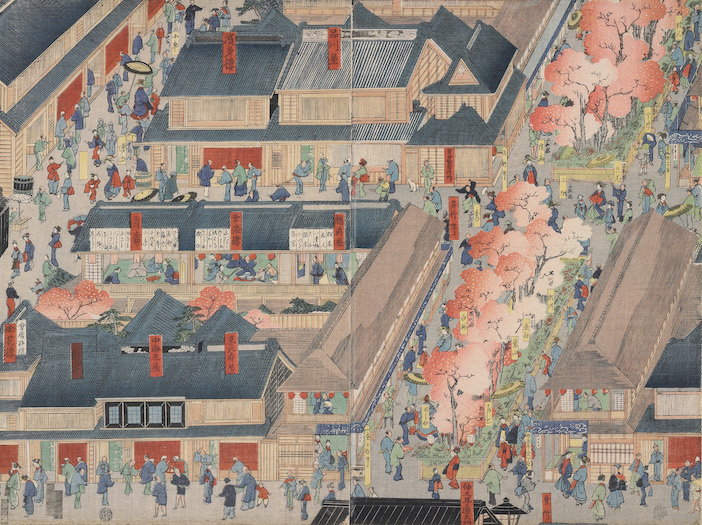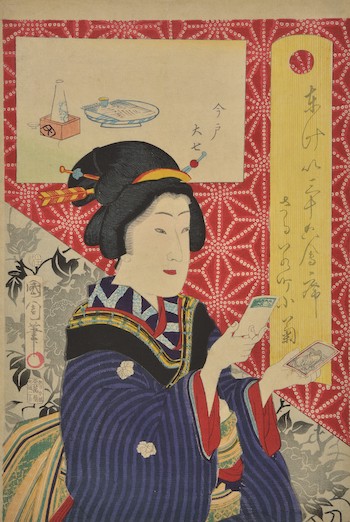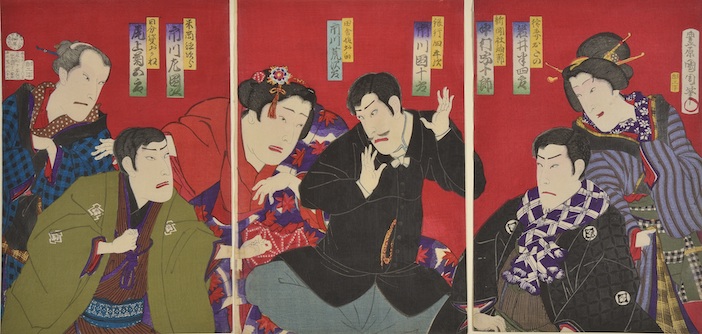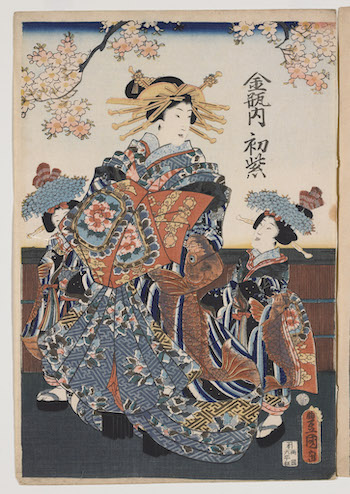“I have been collecting these prints for nearly fifty years and have them hanging all over my house – they cheer me up.”
That’s art historian and collector Frank Milner, speaking about his remarkable collection of woodblock prints from the Edo-era in Japan. Over 50 prints, dating from 1825 – 1895, including some on public display for the first time, are highlights from his collection, in a new exhibition at Watts Gallery Artists’ Village, in Compton, near Guildford in Surrey.
As Milner points out, the prints on show were created during the Victorian era, and yet how different they are, drenched in colour and spectacle, in contrast to the muted colour schemes we associate with the period. “We sometimes think that Japanese prints are mostly about landscape,” Frank explains, “but they’re actually about people…” and this show focuses on life in the metropolis of Edo, when the city with over one million inhabitants was the most-populated in the world.

The New Shimabara Pleasure Quarter, Edo (1869)
In 1868, the city of Edo changed its name to Tokyo under a new government, ending a 250-year era, and while woodblock colour prints continued to be popular, they now included a new modernity with steam trains and photography and modern-dress plays. The fabulous The New Shimabara Pleasure Quarter, Edo, by Kuniteru II Utagawa (Kunitsuna II) sets the scene for this rare, extraordinary show.
In the mid-nineteenth century, when Japan opened its borders, Edo prints circulated in Europe and were collected by artists including Vincent van Gogh – he mentions purchasing, and studying them, making positive comments on Japanese prints in his letters – and Monet, Whistler, Rossetti and Degas amongst others. In ‘Edo Pop’ one enters a spectacular survey of social life at the time, showing many outdoor festivals, popular in summer with thousands of visitors.

The Geisha Kogiku Looking at Photographs (1870)
Collector prints included contemporary images like The Geisha Kogiku Looking at Photographs (1870) by the famed woodblock designer Toyohara Kunichika, as well as prints of domestic life, street scenes and interiors, such as Looking Impatient, a Kaei Era Fireman’s Wife, from 1888, by the famed designer Tsukioka Yoshitoshi, invoking how professional firemen were integral to city life.
Similarly coveted were illustrations of celebrated Sumo wrestlers. Then, as now, celebrity was revered, and became an important factor in print collecting. Above all was the Kabuki theatre that produced popular dramas, both domestic and historical. While the actors performed on stage in a packed auditorium, the audience in front and on either side were eating and drinking and chatting.
It was a tremendous social occasion and the most dominant public entertainment in Edo. There are woodblock prints of the leading actors of the day in fabulous make-up, their faces a white mask to highlight the colours, particularly the lip red contrasting the black-lined eyebrows, so expressive and eye-catching.
A great example is Danjuro IX Concentrating (1881) by Toyohara Kunichika. Three-quarters of the woodblock prints from this era were of Kabuki actors. The prolific designer Kunichika was greatly in demand, producing variations on a theme for all print buyers, such as a traditional scene Three Actors and Egrets in an Edo Winter Setting (main picture), from 1864, and contemporary audiences in An All-Women Group of Fans Watch a Kabuki Play at the Morita Theatre (1871), and modern productions as Scene From the Kabuki Adaptation of Edward Bulwer Lytton’s Play Money from 1879.

Scene From the Kabuki Adaptation of Edward Bulwer-Lytton’s Play Money (1879)
A popular area to visit in Edo was the licensed pleasure quarter. Originally established near Nihombashi in 1618, a widespread fire moved it to north of Asakusa, and it became Shin Yoshiwara (or ‘New’ Yoshiwara). It was square in shape, surrounded by water, and clientele had to cross the moat by bridge to enter the main gate. In the exhibition there are woodblock prints of the stunning 19th-century high-class courtesans.

Detail from Three Senior Oiran on Parade in the Yoshiwara Edo (1853)
The prints were prized and collected for the sensational beauty of the women and the high-fashion clothing they promoted. Three Senior Oiran on Parade in the Yoshiwara, Edo (1853) – Oiran being the highest-ranked courtesans – by Utagawa Kunisada illustrates the scene. Yoshiwara was Edo’s famous entertainment district and open to all, whether to enter the expensive brothels and tea houses, or simply to watch the street entertainment.
The origins of Japanese woodblock printmaking lie in the 8th century, first created to print Buddhist texts in black and white. Printing boomed in the Edo period, highly active from 1603 to 1868. At its peak there were 250 print publishers in Edo. At the Watts Gallery, accompanying Edo Pop, is a site-specific work by Tokyo-born artist Hiroko Imada, Sakura saku (‘Cherry blossoms are blooming’), a woodblock print of many pieces that hangs like a vision of Japan’s beautiful cherry blossom trees.
On display in the Sculpture Gallery, the work links 19th-century Edo woodblock prints to the present day. And from 20th June the gallery presents ‘Hanga Ten: Japanese Printmaking Today’ showing how present-day Japanese printmakers have explored the woodblock printing process to create contemporary art.
‘Edo Pop: Japanese Prints 1825-1895’ is on at Watts Gallery until 6th October 2024. Hanga Ten: Japanese Printmaking Today runs from 20th June to 1st September 2024. For more information, including other events in Japan Season at the gallery, please visit www.wattsgallery.co.uk.
Header image: Three Otokodate and the New Shimbashe Station (detail), 1872, by Toyohara Kunichika




